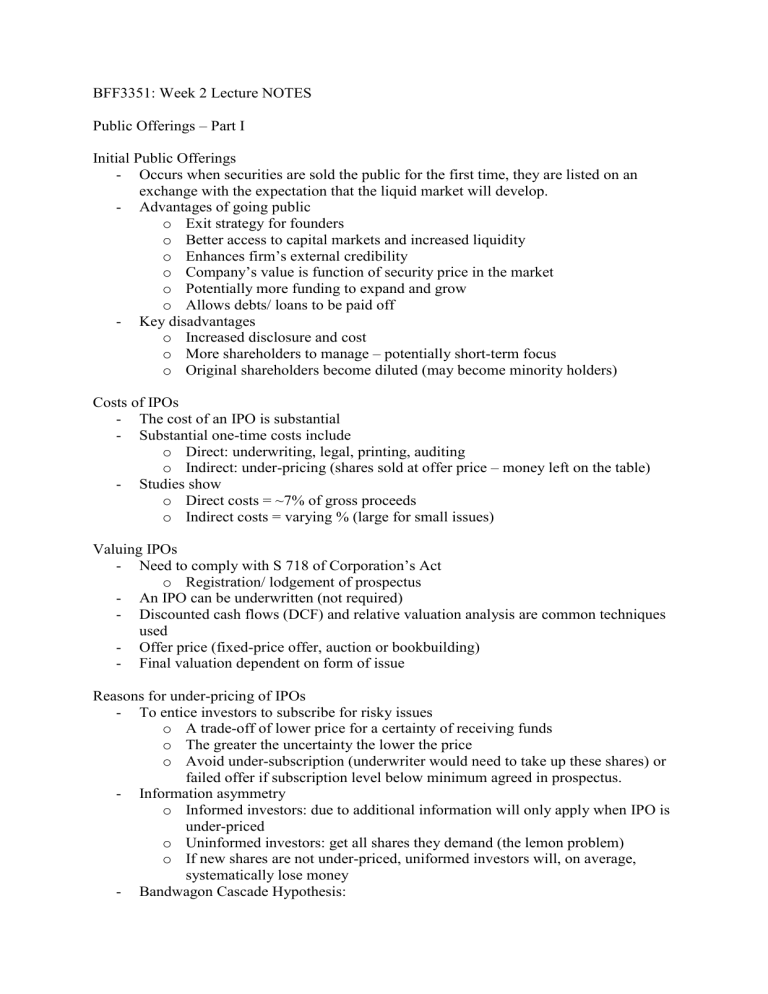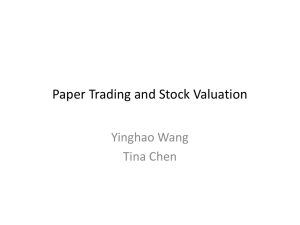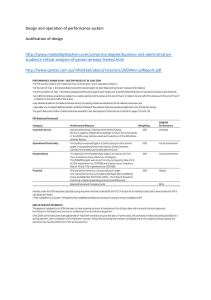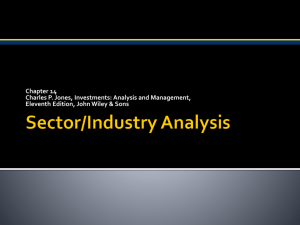
BFF3351: Week 2 Lecture NOTES Public Offerings – Part I Initial Public Offerings - Occurs when securities are sold the public for the first time, they are listed on an exchange with the expectation that the liquid market will develop. - Advantages of going public o Exit strategy for founders o Better access to capital markets and increased liquidity o Enhances firm’s external credibility o Company’s value is function of security price in the market o Potentially more funding to expand and grow o Allows debts/ loans to be paid off - Key disadvantages o Increased disclosure and cost o More shareholders to manage – potentially short-term focus o Original shareholders become diluted (may become minority holders) Costs of IPOs - The cost of an IPO is substantial - Substantial one-time costs include o Direct: underwriting, legal, printing, auditing o Indirect: under-pricing (shares sold at offer price – money left on the table) - Studies show o Direct costs = ~7% of gross proceeds o Indirect costs = varying % (large for small issues) Valuing IPOs - Need to comply with S 718 of Corporation’s Act o Registration/ lodgement of prospectus - An IPO can be underwritten (not required) - Discounted cash flows (DCF) and relative valuation analysis are common techniques used - Offer price (fixed-price offer, auction or bookbuilding) - Final valuation dependent on form of issue Reasons for under-pricing of IPOs - To entice investors to subscribe for risky issues o A trade-off of lower price for a certainty of receiving funds o The greater the uncertainty the lower the price o Avoid under-subscription (underwriter would need to take up these shares) or failed offer if subscription level below minimum agreed in prospectus. - Information asymmetry o Informed investors: due to additional information will only apply when IPO is under-priced o Uninformed investors: get all shares they demand (the lemon problem) o If new shares are not under-priced, uniformed investors will, on average, systematically lose money - Bandwagon Cascade Hypothesis: - - - o A potential investor pays attention not only to information but to whether other investors are purchasing o Under-pricing induces first potential investors to buy Lawsuit Avoidance Hypothesis: o Due possibility of investor lawsuits for losses sustained, under-pricing may reduce frequency and severity of lawsuits Signalling o Under-pricing leaves good taste with investors, allowing sale of future offerings at higher price than otherwise Regulatory Constraints o On privatisation, gives investors a good taste of capitalism Underwriter reputation o Higher reputation/ lower underwriting o Likely parallel direction in fees o Underwriters can reward favoured clients by allocating shares in IPOs likely to be under-priced Going Public Process - Underwriting o May have dual role of underwriter/ marketer Underwriting means absorbing/ buying/ retaining any shortfall shares in the offer o Role of sub underwriters o Existence of underwriting agreements Use of out clauses under specific agreements - Risks of underwriting o Issue size in terms of underwriter’s balance sheet o Length of time-table for which underwriters are a risk Bookbuilding - A US developed concept o Greater flexibility in promotion prior to registration of prospectus o Retail investor interest can be recorded/ calculated o Price set after. Road show and building book of interest o May only be underwritten as to settlement risk o Seeks to match supply and demand - Minimises time between pricing of issue and trading in secondary markets - Bookbuilding via a “road show” Tender Offers - Tender offers are made above minimum price - If offer is oversubscribed, priority is given to highest tenderer - Two techniques used: o Common strike price method o Pure tender method - Pure tenderer: o Highest bid wins o Not used now - Common strike method o Investors submit competitive bids for specific amounts of shares at various prices o Common strike price is determined for all investors, based on which there is most demand o Encourages higher bids to secure share allocation. If shares are tendered at too high a price, bidders receive shares at same price as other investors Open Price Bookbuilding - Followed in US: final price set at end of offering period - Use of the indicative price range delivers more accurate pricing level - Provides guide as to value of shares - Prices set by lead managers and issuing firms o Lower end at sufficiently attractive level to firm o Higher end at price which exceeds issuing firm’s price objective, but is realistic o Range about 10% - If strong demand indicated, final price can be at or above upper limit - If demand is low, offer can be withdrawn, or price range reduced Constrained open pricing - A dual pricing basis - Retail investors apply at capped price - Institutional and foreign investors pay strike price (after bookbuilding) - E.g., Medibank Green Shoe Public Offerings Relative valuation/ Market Comparable - Technique used to value businesses, business units and other major investments o Assumes similar assets should sell at similar prices o The critical assumption underlying the approach is that the “comparable” assets/ transactions are truly comparable to the investment being evaluated - Relative valuation should be used to compliment DCF analysis - Steps in relative valuation o Step 1: Identify similar or comparable investments and recent market prices for each o Step 2: Calculate a valuation metric for the asset o Step 3: Calculate an initial value of the asset o Step 4: Refine the valuation to the specific characteristics of the asset Equity Valuation using price to earnings (P/E) ratio - Analysts usually focus on predicting the earnings of firms they evaluate and then use the P/E ratio to evaluate the price of common stocks - Earning power is a chief driver of investment value, EPS (the denominator for P/E) is the chief focus of most security analysts - The P/E ratio is widely considered as the most familiar valuation method o Estimated value of firm equity = (price per share of comparable firm / Earning per share of comparable firm) x earning per share of firm being valued Trailing or Leading - The current price can be observed, as can earnings o However, earnings can be reported earnings (trailing) or forecast earnings (leading) - The trailing ratio uses reported earnings (historical earnings) and will generate a different result to the leading ratio if companies have growth - It is important to apply a trailing P/E ratio to reported earnings and a leading P/E ratio to forecast earnings when estimating price - Trailing P/E ratio: P0/E0 - Leading P/E ratio: P0/E1 Leading P/E ratio = (payout ratio) / (r – g)






